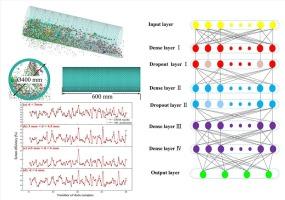Machine learning prediction of screening efficiency of new drum screen based on Harris Eagle algorithm optimization
IF 5
2区 工程技术
Q1 ENGINEERING, CHEMICAL
引用次数: 0
Abstract
As a core screening device in mineral processing and construction industries, the efficiency of a drum screen is governed by multiple nonlinearly coupled parameters, rendering traditional empirical models inadequate for high-precision prediction. This study presents an integrated machine learning framework combining the Discrete Element Method (DEM) with the Harris Hawks Optimization (HHO) algorithm to dynamically model the trommel sieving rate of a novel screen. Initially, a high-dimensional dataset comprising 810 samples—including particle size distribution, rotational speed, and drum inclination—was generated via DEM simulations. Subsequently, the HHO algorithm was employed to optimize the hyperparameters of a deep multilayer perceptron (MLP), achieving coefficients of determination (R2) of 0.9864 and 0.9760 on the training and test sets, respectively. To generalize the model across varying drum lengths, a variable-screen-length iterative prediction algorithm was developed; results demonstrate that for drum lengths exceeding 300 mm, the prediction error remains below 3 % and decays exponentially with increasing length. Global sensitivity analysis identified drum inclination (26.01 %) and fine-particle feed rate (24.73 %) as the predominant factors influencing screening efficiency. Moreover, interpretability analysis indicated that fine-particle feed rates (“d < 3 mm”, “3 mm < d < 4.5 mm”) and drum inclination consistently serve as the primary drivers of model predictions, although the model exhibits context-dependence with notable variations across output regimes. The proposed approach offers robust theoretical and technical support for the intelligent design and parameter optimization of drum screening equipment.

基于Harris Eagle算法优化的新型滚筒筛筛效机器学习预测
作为选矿和建筑行业的核心筛分设备,滚筒筛的效率受多个非线性耦合参数的影响,传统的经验模型无法进行高精度预测。本研究提出了一个集成的机器学习框架,将离散元法(DEM)与哈里斯鹰优化(HHO)算法相结合,以动态建模一种新型筛网的筛分率。首先,通过DEM模拟生成了包含810个样本的高维数据集,包括粒度分布、转速和滚筒倾角。随后,利用HHO算法对深度多层感知机(MLP)的超参数进行优化,在训练集和测试集上分别获得了0.9864和0.9760的决定系数(R2)。为了将模型推广到不同滚筒长度的情况下,开发了一种变筛长迭代预测算法;结果表明,当滚筒长度超过300 mm时,预测误差保持在3%以下,并随着滚筒长度的增加呈指数衰减。全局敏感性分析表明,滚筒倾角(26.01%)和细粒进料率(24.73%)是影响筛分效率的主要因素。此外,可解释性分析表明,细颗粒进给量(“d < 3mm”,“3mm < d < 4.5 mm”)和滚筒倾角始终是模型预测的主要驱动因素,尽管模型在不同的输出模式下表现出明显的环境依赖性。该方法为鼓式筛分设备的智能化设计和参数优化提供了有力的理论和技术支持。
本文章由计算机程序翻译,如有差异,请以英文原文为准。
求助全文
约1分钟内获得全文
求助全文
来源期刊

Minerals Engineering
工程技术-工程:化工
CiteScore
8.70
自引率
18.80%
发文量
519
审稿时长
81 days
期刊介绍:
The purpose of the journal is to provide for the rapid publication of topical papers featuring the latest developments in the allied fields of mineral processing and extractive metallurgy. Its wide ranging coverage of research and practical (operating) topics includes physical separation methods, such as comminution, flotation concentration and dewatering, chemical methods such as bio-, hydro-, and electro-metallurgy, analytical techniques, process control, simulation and instrumentation, and mineralogical aspects of processing. Environmental issues, particularly those pertaining to sustainable development, will also be strongly covered.
 求助内容:
求助内容: 应助结果提醒方式:
应助结果提醒方式:


